Tsamkhung Nunnery, also known as “Ani Tsamkhung Monastery” or “Tsamkhung Monastery” in short, is a Gelug Pa nunnery of Tibetan Buddhism.
Tsamkhung Nunnery got its name from this retreat cave. The Tibetan term “Tsamkhung” means “Retreat Cave.”
It is located at No. 29, Linkuo South Alley, southeast of Jokhang Temple in Lhasa.
According to legend, during the reign (AD 629 – AD 650) of Songtsen Gampo King of Tubo Dynasty, Songtsen Gampo practiced in a cave on the southeast side of Jokhang Temple to subdue a water demon and prevent the Lhasa River from flooding Jokhang temple and the city of Lhasa.
In the 15th century, Khyunga Dongden (1386-1445) visited this place for pilgrimage and built a small gonpa around this retreat cave.
Historically, the monastery has been governed by successive Pabongka masters.
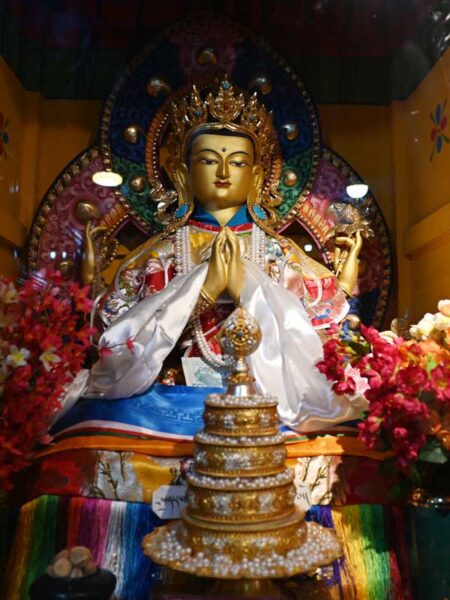
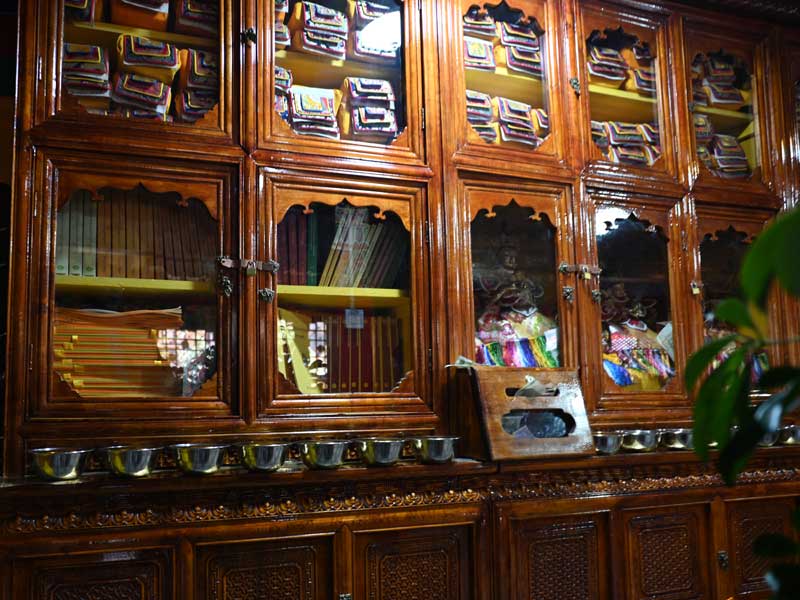
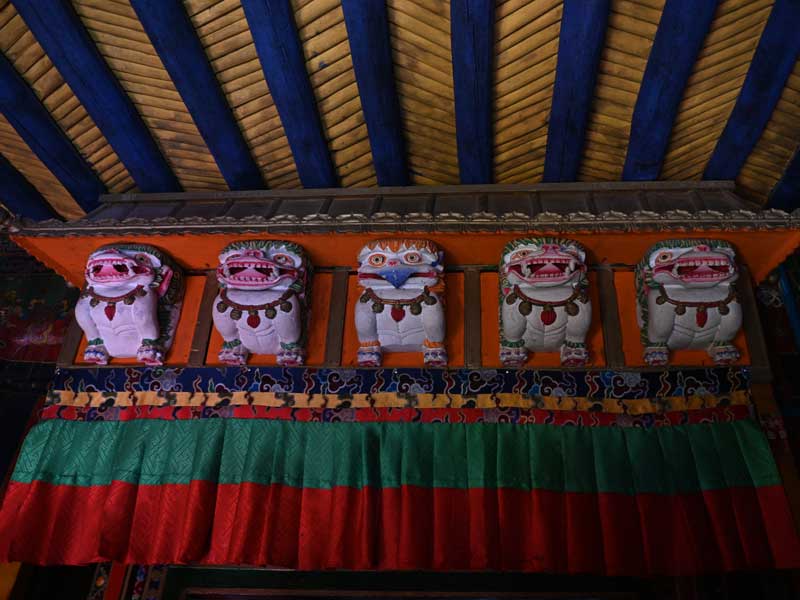
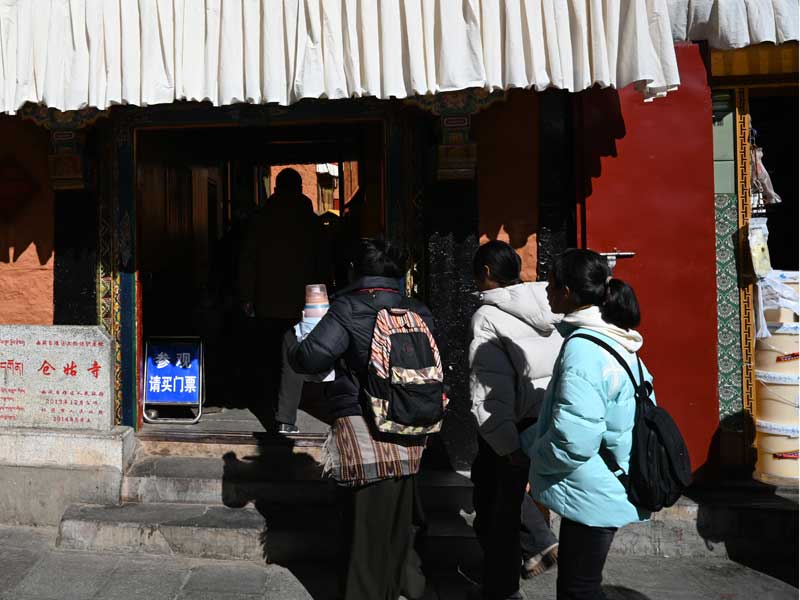
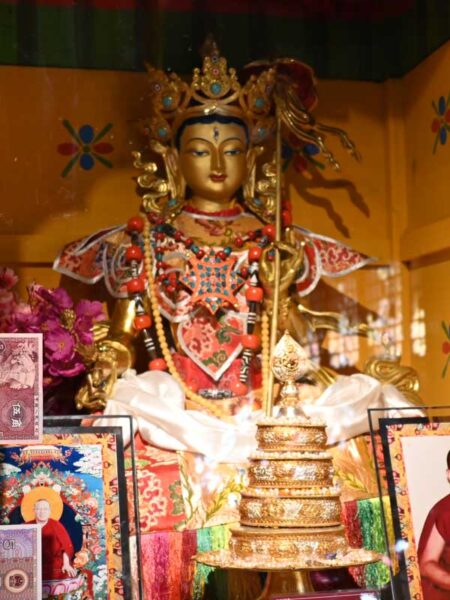
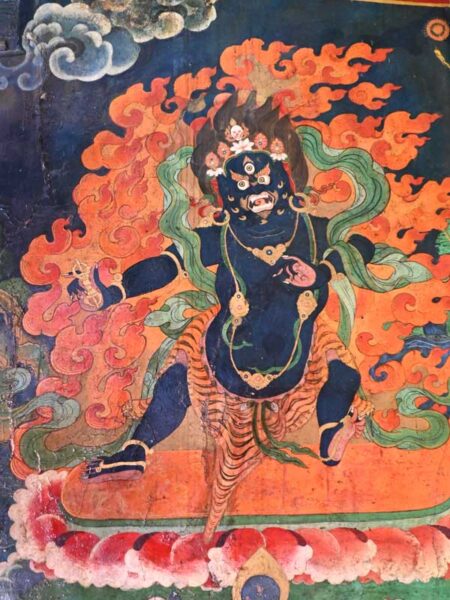
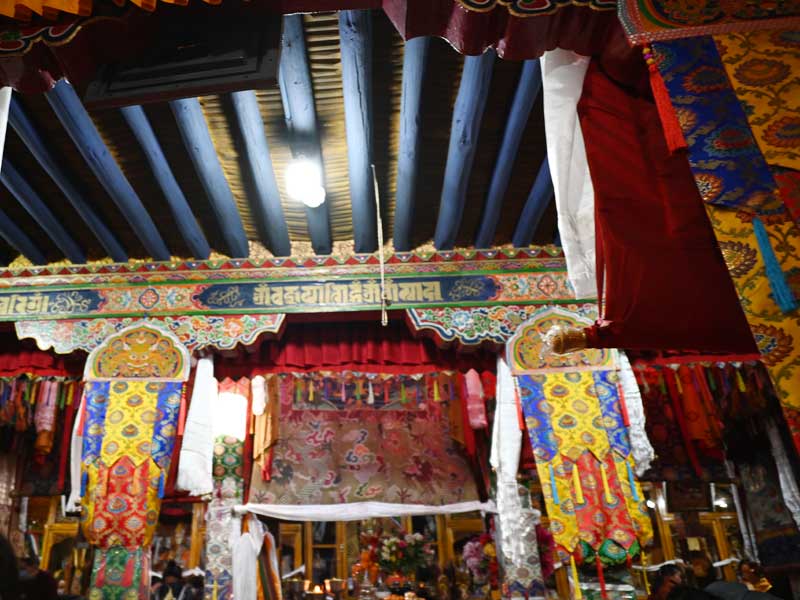
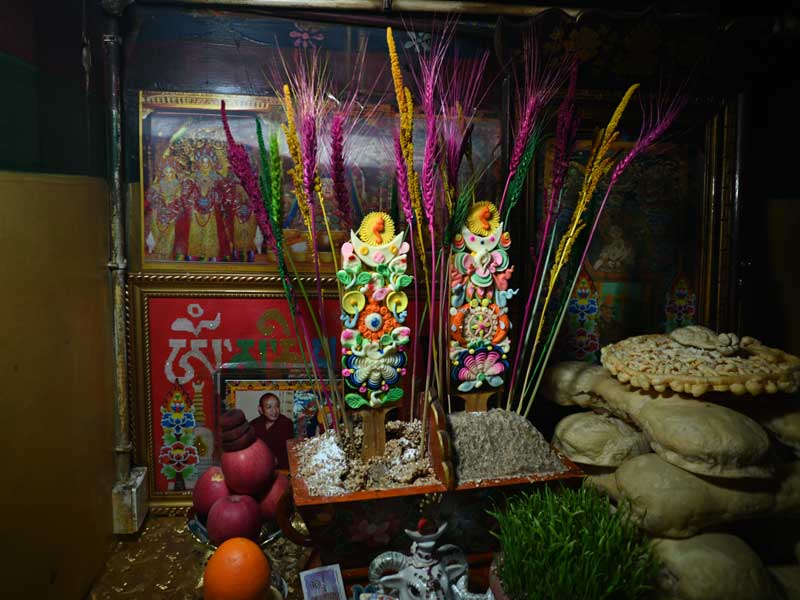
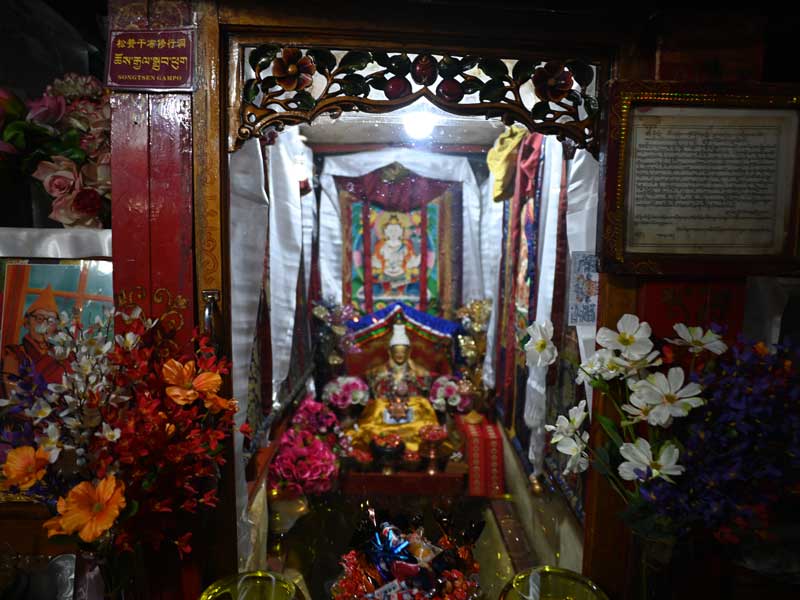
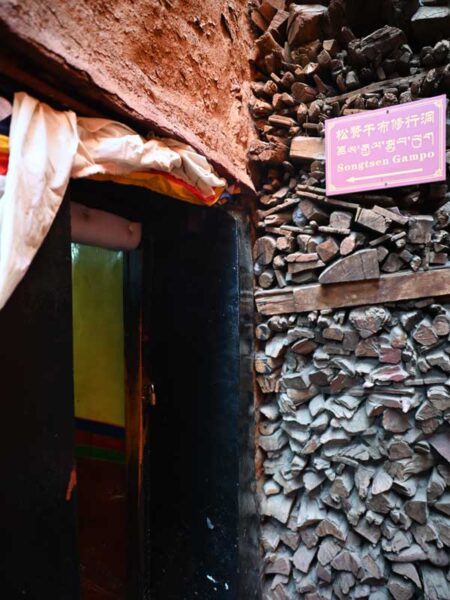
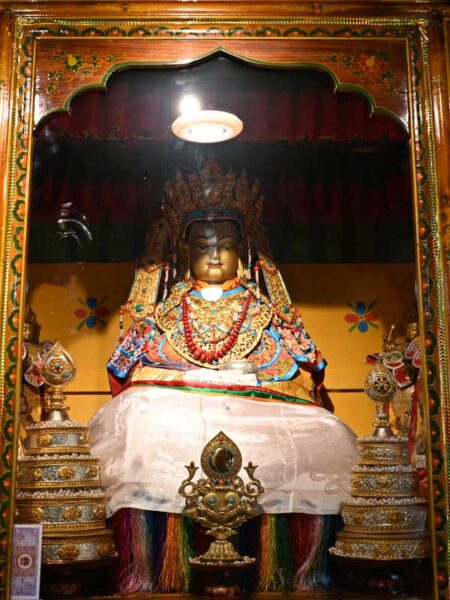

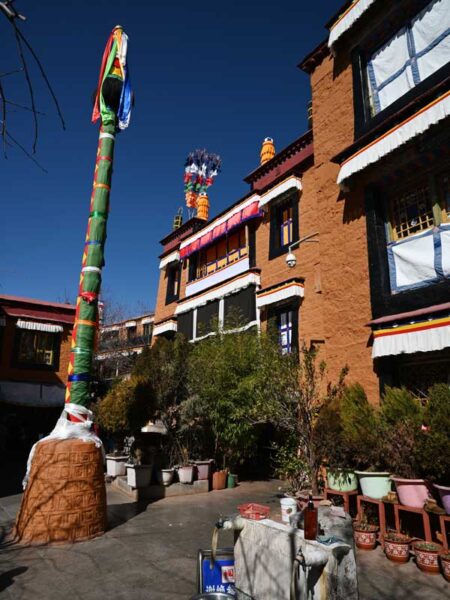
Brief History
The history of the nunnery dates back to the 7th century during the Tibetan Empire period.
At that time, every summer, the floodwaters from the valleys upstream of the Lhasa River would converge into the river, causing sudden surges and frequent flooding. This often resulted in significant damage to the farmland and villages along the banks, bringing great disaster and loss to the local Tibetan people.
To mitigate the impact of the Lhasa River on the people and the city, Tibetan King Songtsen Gampo, following Buddhist teachings, dug a pit (a retreat cave) on the river’s embankment. He then meditated and chanted prayers there to subdue the water demon and prevent floods.
Later, people called the retreat cave where Songtsen Gampo practiced “Tsamkhung,” meaning “retreat cave.”
In the 12th century, a renowned healer named Je Wabum practiced meditation in this cave, achieving great accomplishments and further enhancing the cave’s fame.
In the 15th century, Tsongkhapa’s esteemed disciple Khyunga Dorje Denpa officially built a monastery around the retreat cave, calling it “Tsamkhung Monastery.” However, at that time, the monastery was not very large, consisting of a single-story building with eight pillars. The northern room housed the pit where Songtsen Gampo meditated, while the southern room contained a black stone statue of Songtsen Gampo and a mask he used.
The monastery also featured clay statues of Amitayus, Padmasambhava, and Dorje Langgye. Eight hand-turned prayer wheels made of red clay were built beside the monastery. At that time, there were fewer than 10 nuns in the monastery.
The walls inside were covered with murals, with Tsongkhapa in the center, wearing a yellow pointed hat, making the Dharma Wheel mudra, with two lotus flowers blooming from his hands and resting on his shoulders. Surrounding him were images of his disciples Khedrub Je, Gyaltsab Je, Rinchen Tsultrim, and Duldzin Dragpa Gyaltsen, as well as Pabongka’s portrait.
Later, Pabongka Rinpoche expanded the monastery, increasing its height to two stories with 16 large and small pillars, adding a porch and skylights, and the number of nuns increased to 10.
In the early 20th century, Pabongka Rinpoche and the 9th Ganden Tripa(abbot), Jampa Chödrak, funded further expansions, gradually forming the current scale of Tsamkhung Nunnery.
During the Cultural Revolution in the 1960s, Tsamkhung Nunnery suffered severe damage, and its relics were dispersed.
In 1982, the local government allocated funds for restoration, largely restoring its original appearance, retaining the two-story structure.
In October 1984, the northern room, where Songtsen Gampo’s retreat cave was located, was renovated to its original state. The retreat cave is oriented east-west, trapezoidal in shape, with the upper base 1.1 meters wide, the lower base 0.87 meters wide, and 1.5 meters deep. Four sloping steps on the eastern side lead down to the cave’s bottom.
The nunnery currently has 12 nuns who engage in regular religious activities.
Architecture
Tsamkhung Nunnery faces south and includes a main hall, nun dormitories, and a nun kitchen.
The main hall houses a statue of Shakyamuni Buddha and 13 thangkas collected from other monasteries.
To the left of the entrance is the nunnery’s self-operated sweet tea house and a small shop that sells Tibetan-style curtains, Buddha garments, and monk robes made by the nuns, which help support the nunnery’s expenses.
A pathway leads into the nunnery’s courtyard. The first things seen are a short row of prayer wheels and an incense burner.
To the right of the pathway, there are several posters promoting modern fire safety awareness, painted in traditional thangka style.
On the right side of the courtyard is a sweet tea house run by the nuns, offering Lhasa sweet tea, Tibetan vegetarian dumplings, and more.
On the left side of the courtyard is the kitchen, which also serves as the reception area for the nunnery’s management committee, where they greet guests, accept donations, and organize rituals.
Directly ahead in the courtyard is the main hall. The hall is not very large and consists of two levels: the upper level is the prayer hall, and the lower level is used for daily activities.
Ascending the steps, the entrance is flanked by murals of the Four Heavenly Kings. The eaves and door pillars are decorated similarly to other Tibetan Buddhist temples, with traditional lion and human faces carved on the upper parts of the pillars.
The main deity worshiped at Tsamkhung Nunnery is the Eleven-faced Avalokiteshvara. There are also statues of Manjushri, Amitayus, Je Tsongkhapa, Tara, and 13 thangkas from the Ming and Qing dynasties, along with other Gelugpa masters and Buddha statues.
In the upper left corner of the main hall are two statues of Pabongka masters.
Exiting the main hall and following a small path beside it leads to Songtsen Gampo’s retreat cave. This cave is about 2 meters underground and contains a statue of the Tibetan king Songtsen Gampo. Three dedicated nuns perform daily prayers, offer offerings, and maintain the oil lamps there.
Connection with Jokhang Temple
Tsamkhung Nunnery is not affiliated with any other monastery.
During the Cultural Revolution, the monastery was closed.
In 1980, following the implementation of new religious policies, the monastery reopened. From its reopening until 1985, it was administratively under the jurisdiction of Jokhang Temple. The local government’s donations during the Great Prayer Festival were also transferred to the monastery by Jokhang Temple.
Later, Ani Tsamkhung Monastery established its own Management Committee and was no longer affiliated with Jokhang Temple.
Around the year 2000, the situation was such that the Buddhist scriptures used for enshrining statues made by the nuns of this monastery were all provided for use by Jokhang Temple, which paid the nuns their wages. The yellow paint on the monastery walls was repainted once a year by workers from Jokhang Temple on a voluntary basis.
Other than these connections, the monastery had no other ties with Jokhang Temple.
Ritual Activities
As a place of practice for women, Tsamkhung Nunnery focuses on the transmission and promotion of Avalokiteshvara and Tara rituals and practices.
For instance, the nunnery frequently conducts offering ceremonies such as the “Tara Offering Ritual,” the “Vajrayogini Practice Ritual,” and the “Ushnishavijaya Longevity Ritual.”
According to the nunnery’s schedule, daily practice sessions, which include the offering ceremony, are held in the main hall from 8 a.m. to 4 p.m. Additionally, seven large collective chanting ceremonies are held each month.
Ani Tsamkhung Monastery does not have its own system of reincarnated lamas (tulkus);
Features of the Nunnery
Tsamkhung Nunnery has a unique tradition and style. It serves as a place for female Buddhists to learn various cultural knowledge and has produced many influential figures.
The nuns at Tsamkhung Nunnery chant scriptures in the main hall every morning at 8 a.m. for their daily practice, which lasts until 4 p.m.
Additionally, several large-scale collective chanting ceremonies are held each month.
During the autumn, when religious activities decrease, the impoverished nuns travel to the pastoral areas of Shannan and Northern Tibet to seek alms or work for others to earn food.
For the Tibetan New Year, they have a five-day holiday provided by the monastery, during which the nuns gather to dance, sing, and perform Tibetan opera, creating a lively atmosphere.
At its peak, the nunnery housed over 200 nuns, making it one of the most famous nunneries in Tibet.
Before 1950, the aristocrats and merchants of old Tibet often sent their wives, concubines, and daughters to the nunnery for a period of Buddhist study to improve their knowledge and cultural level. Consequently, Tsamkhung Nunnery held significant influence among female devotees in Lhasa.
Internal Management
As the governing body of Tsamkhung Nunnery, the Monastery Management Committee consists of four members, namely the director, deputy director, and two committee members. Each member has their own responsibilities, overseeing religious activities, management, and other affairs within the monastery.
Additionally, the monastery has appointed instructors and chant leaders according to their level of practice, responsible for daily discipline supervision and Buddhist activities.
A storage room is designated for alms, managed by three younger nuns who rotate every two years based on their level of practice. Any remaining finances from alms must be transferred to the next rotation.
Furthermore, several young nuns are responsible for daily tasks such as monastery kitchen duties.
Personnel
Many women aspire to become nuns at this monastery, but due to limited housing and facilities, the monastery implements a strict examination system to select outstanding candidates.
Specifically, candidates must be able to fluently recite 500 pages of scriptures to be admitted to Tsamkhung Nunney. Memorizing scriptures takes a considerable amount of time, and some women spend up to 16 years without passing the exam.
Most of the nuns at the monastery come from areas such as Shannan, Nyingchi, and Dazi, attracted by the reputation of the monastery.
Sources of Income
The primary sources of income for Tsamkhung Nunney rely on offerings from benefactors and donations from religious followers.
In addition, to supplement these funds, the monastery operates businesses such as teahouses, restaurants, and clinics nearby.
However, most of these businesses operate with a charitable nature, offering not only quality products at reasonable prices but also attentive service.
Today, Tsamkhung Nunnery continues to engage in various business ventures. Its sweet tea is particularly renowned for its mild flavor, making it the lightest among the well-known sweet tea houses in Lhasa.
Most of the dormitories in the monastery are self-built by the nuns, but the property rights belong to the monastery.
After a nun passes away or returns to secular life, if there are no disciples who can inherit the dormitory, the property is reclaimed by the monastery and resold to other nuns, with the proceeds going into the monastery’s savings.
The personal income of the nuns comes from various sources: The monastery provides each nun with a monthly stipend of 400 RMB, those from relatively affluent families are supported by their families, while others rely on income from engaging in religious activities outside the monastery. A few impoverished nuns even earn a meager income by doing laundry for others.



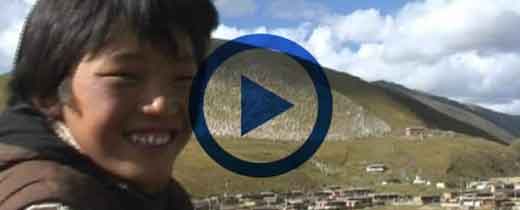

Leave a Reply